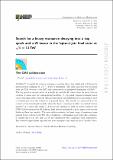Search for a heavy resonance decaying into a top quark and a W boson in the lepton+jets final state at s $$ \sqrt{s} $$ = 13 TeV
Author(s)
Tumasyan, A.; Adam, W.; Andrejkovic, J. W.; Bergauer, T.; Chatterjee, S.; Damanakis, K.; Dragicevic, M.; Escalante Del Valle, A.; Frühwirth, R.; Jeitler, M.; Krammer, N.; Lechner, L.; Liko, D.; Mikulec, I.; Paulitsch, P.; Pitters, F. M.; Schieck, J.; Schöfbeck, R.; ... Show more Show less
Download13130_2022_Article_18155.pdf (965.3Kb)
Publisher with Creative Commons License
Publisher with Creative Commons License
Creative Commons Attribution
Terms of use
Metadata
Show full item recordAbstract
Abstract
A search for a heavy resonance decaying into a top quark and a W boson in proton-proton collisions at
s
$$ \sqrt{s} $$
= 13 TeV is presented. The data analyzed were recorded with the CMS detector at the LHC and correspond to an integrated luminosity of 138 fb−1. The top quark is reconstructed as a single jet and the W boson, from its decay into an electron or muon and the corresponding neutrino. A top quark tagging technique based on jet clustering with a variable distance parameter and simultaneous jet grooming is used to identify jets from the collimated top quark decay. The results are interpreted in the context of two benchmark models, where the heavy resonance is either an excited bottom quark b∗ or a vector-like quark B. A statistical combination with an earlier search by the CMS Collaboration in the all-hadronic final state is performed to place upper cross section limits on these two models. The new analysis extends the lower range of resonance mass probed from 1.4 down to 0.7 TeV. For left-handed, right-handed, and vector-like couplings, b∗ masses up to 3.0, 3.0, and 3.2 TeV are excluded at 95% confidence level, respectively. The observed upper limits represent the most stringent constraints on the b∗ model to date.
Date issued
2022-04-08Department
Massachusetts Institute of Technology. Department of PhysicsPublisher
Springer Berlin Heidelberg
Citation
Journal of High Energy Physics. 2022 Apr 08;2022(4):48
Version: Final published version